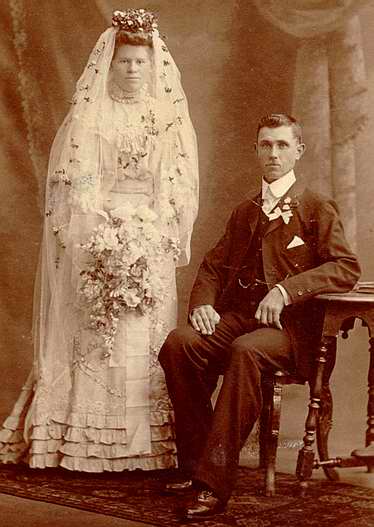Tschirpig Family
in South Australia
by Brian Vogt
My mother :
This is a brief genealogy of Grace Doreen Vogt, nee Tschirpig – 11 May 1928 to 22 July 2005.
Click here to read my account of her funeral.
Click here to see her ancestral tree in a secondary window.
How is that surname Tschirpig pronounced? Mum was only taught how English types like to read it – "Sher-pig."
The trouble is that it's written in the German alphabet. Although the letter shapes look familiar, the sounds
don't match those for the English alphabet. Mum's late brother Allen once recounted to me that his grandfather
taught him to say "Chi-rrr-pich" – "Ch" in English phonetics, "i" (as in "it"), the rolling "r",
"pi" as in "pit", and finishing with the German "ch" sound not existing in English.
The sounds are a bit explosive, so I never say it when I have food in my mouth.  In fact, it requires a brief warm-up exercise first.
In fact, it requires a brief warm-up exercise first. 
In Germany (where I've lived and researched Dad's genealogy to completion),
a trailing "g" is usually spoken according to the regional accent. It can be a normal g (as in "pig"), or
identical to the German "ch", or identical to the German "sch" (the version I dislike intensely). It's
perfectly fair to conclude that Uncle Allen learnt well, despite never having visited Germany.
Language at home was quite a mixture. Mum's parents were completely bilingual, although at home they preferred to
speak German according to their upbringing. I recall (from 1965) that her mother had a half-German accent when she
spoke English, despite being the second generation born in Australia. Mum understood what her parents were saying in
German, but always replied in English. After childhood, the German words were quickly forgotten.
In the last 3 years of her life, I took Mum to her ancestors' graves at Krondorf (see below).
She was unable to understand the German inscriptions, so I translated them for her.
Mum's original home was the family farm house very close to
Yatco Lagoon
which was made permanent by Lock 3 in the River Murray (only a flood plain before that), between Moorook and Loxton in South Australia.
The house (see photo below) is south of the main body of the lagoon, almost in line with Drogemuller Road.
Click here to see an Upper Murray region map in a secondary window.
Click here to do a Google Earth placemark tour or see a Google Map of the important places.
The last of 8 children, she was born in Loxton Hospital on 11 May 1928. Actually, she was born prematurely and not
expected to live. Her father overlooked his obligation to register her at the police station – a point
that was discovered only when she applied for a marriage licence in 1949.
Part of her schooling was in Moorook (while living with relatives, on a farm but
at least 1 km closer to Moorook), and the remainder was at the 1-classroom Yinkanie school (a 4 km walk from home).
| 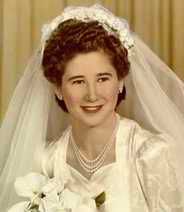 |
The children of the family:
| |
Flora ("Flo") – born 7 February 1908, died 12 October 1999, buried Moorook
Alwin ("Butch") – born 10 December 1909, died 1 December 1973,
cremated after funeral at Centennial Park, plaque in Barmera Cemetery
Alma – born 15 March 1911, died 25 November 1923 (aged 12), buried Moorook
Oswald ("Os" or "Ossie") – born 17 April 1914, died 15 March 1974, buried Moorook
Herbert ("Snow") – born 21 April 1921, died 9 January 2010, buried Barmera
Norman ("Norm" or "Darkie") – born 15 July 1924, died 11 February 2012
Allen ("Megsie") – born 30 August 1926, died 10 September 2002, cremated, ashes placed
at the foot of the very tall palm tree planted by his mother at the Moorook homestead
Grace – born 11 May 1928, died 22 July 2005, buried in Kapunda Cemetery
|
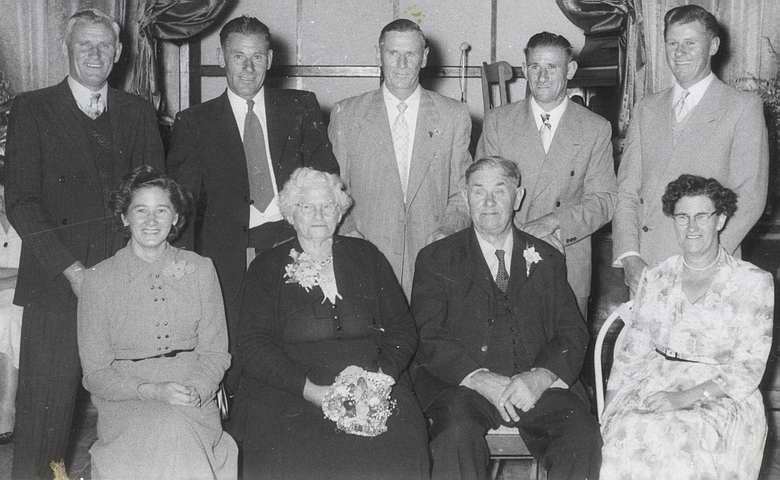
At the Golden Wedding Anniversary in 1957.
Top row: Alwin, Oswald, Herbert, Norman, Allen
Bottom row: Grace, mother Anna, father Traugott, Flora
An extract from page 78 of the book "Moorook – Bend in the River" –
| |
A transportable school room was brought from Kadli to Yinkanie siding. An iron
shelter shed, a flagpole, phonograph and records, three framed pictures and 75 library books were bonus.
Florence E. Horwood opened the school in January 1936 enrolling: Norman Fiegert, Morris Fromm, Allen Tschirpig,
Grace and Norman Tschirpig, Alice and Rhonda Freundt, Dorothy Green, Joyce Thamm, Joyce and Valma Retallick,
Ellen Egel.
Mr. A. Keith Maynard had charge between 1937 and 1940, followed by Miss E.M. Larwood who
transferred from Yinkanie school to Moorook in September 1941. The building was on the
move again, this time to become a woodwork room at the Moorook school. |
Further brief information about Mum's life can be found via the "funeral" link above, then go to the Eulogy.
My grandparents :
Mum's father was Carl Wilhelm Traugott Tschirpig (generally known as Traugott). The
first of 12 children, he was born at Tanunda in the Barossa Valley on 15 February 1876.
Anna Maria Elisabeth and Carl Wilhelm Traugott – wedding on 10 April 1907, and 25 years later
| 1907 Married in the District of Wellington |
| No. |
When Married. |
Name and Surname
to be written in full. |
Age. |
Condition. |
Trade
or
Calling. |
Residence at time of Marriage. |
Name and Surname of Fathers of both Parties. |
Place in which Celebrated. |
| 4 |
April
10th
1907 |
Carl Wilhelm
Traugott Tschirpig
&
Anna Maria
Elisabeth Milich |
31
20 |
Bachelor
Spinster |
Farmer
---- |
Loxtonshut
Pyap |
Carl Wilhelm Friedrich Traugott Tschirpig
Johannes Milich |
Luth. Church
at
Loxtonshut |
This Marriage
was celebrated
between us |
Carl Wilhelm Traugott Tschirpig
Anna Maria Elisabeth Milich
|
In the
presence
of us |
Name.
J T W Milich
E J Tschirpig |
Trade or Calling.
farmer
farmer |
Residence.
Pyap
Sedan |
The above-named Carl Wilhelm Traugott Tschirpig and Anna Maria Elisabeth Milich were duly Married
by or before me, at the time and place above named, and in the presence of the witnesses whose signatures are above written.
Witness my hand this 10th day of April 1907
| |
L E Kufs
Officiating Minister |
|
|
The Upper Murray region was the new area for settlement by descendants of the German migrants, as the Barossa Valley family
farms couldn't reasonably be split amongst 5 or 6 sons. The Upper Murray region had previously been settled and then
substantially abandoned by British types (according to Dr. Ian Harmstorf, the leading historian of
German settlement in S.A.), so there was plenty of land to occupy there.
In 1900, Traugott walked from the town of Eden Valley to Loxton (a distance of 155 km) – presumably
because he couldn't afford any means of transport. The remainder of his life revolved
around butchery and farming in the Loxton/Moorook area. His much younger brother Adolf Bernhard ("Ben") eventually followed him to
Loxton, as it seems 2 other brothers did at some stage. He helped Ben to establish this butchery
business in Loxton.
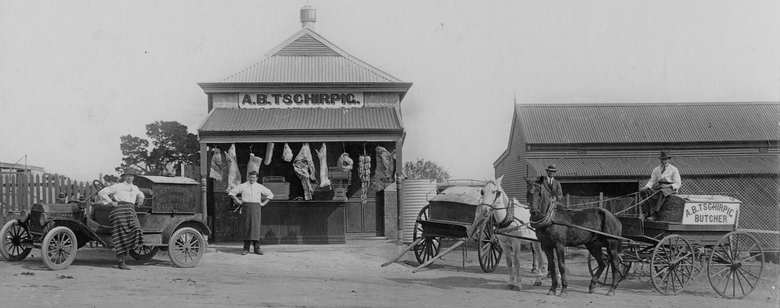
The Advertiser, Monday 17 September 1906, page 8 reported that Loxton's Hut Bicycle and Athletic
Club had recently held its annual picnic and sports day. Traugott was the secretary.
(Footnote: Loxton's Hut was the first name of a settlement, proclaimed as the town of Loxton in 1907. It was named after
William Charles Loxton's former tiny dwelling beside the river, demolished in 1907 due to its dilapidated condition –
described on p.84 of the book Dust, Sweat & Tears)
Traugott was a founding member and official of the Loxton Agricultural and Horticultural Society.
The Advertiser, Tuesday 3 October 1911, page 11 reported on their inaugural show 6 days earlier.
Traugott was the ring steward. He's also in the prize list for "Team of six horses."
The Advertiser, Monday 30 September 1912, page 14 contains a full report on the 2nd annual show
2 days earlier. "Mr. T. Tschirpig's team of six horses driven in reins secured first prize
and would have scored in much stronger company."
The Central Murray Racing Club held its inaugural race meeting at Moorook on Thursday 19 June
1913. Traugott was a member of the committee, and his brother Ben was clerk of the course.
A brief report on their 19 March 1914 race meeting was printed in The Advertiser 4 days later.
"Pony Race, four furlongs.–Mr. Jobst's Betsy, 1; Mr. Drogemuller's Shakemup, 2; Mr. Tschirpig's Moorook Lass, 3."
The Register on Thursday 6 September 1923 listed Traugott amongst the stewards at the Loxton meeting for that day.
In October 1913, the Moorook Vigilance Committee organised a meeting to discuss lobbying the
Railways Standing Committee for the purpose of extending the Waikerie railway line to Moorook and
Kingston-on-Murray. Traugott, who had bought his Moorook farm in 1910, was appointed to a new committee whose task
was to "further the scheme."
Footnote: 1913 was a time of intense railway construction. The Tailem Bend – Karoonda – Alawoona line had
just opened. An extension to Loxton and a spur line from Karoonda to Waikerie were in progress (both opened
in 1914), so the Moorook and Kingston people in the middle must have felt left out. Their requested extension from
Waikerie never eventuated. Instead, another spur line up from Wanbi to Yinkanie was opened in September 1925.
It closed in 1971 and was sold under the
Wanbi to Yinkanie Railway
(Discontinuance) Act, 1980.
In politics, Traugott was a staunch supporter of the Liberal Union. The Advertiser, Wednesday
8 April 1914, page 5 has an article saying that he presided over the Moorook branch. Page 10 on
Wednesday 14 June 1911 says that 2 days earlier he represented the Moorook branch at the district committee meeting at Tailem Bend.
His support turned to the Liberal Party of Australia following its formation in the mid-1940s.
Long-serving state Premier, Sir Thomas Playford knew him and appreciated his enthusiastic support.
On 21 January 1917 he was one of 2 councillors elected (from 4 candidates) to Loxton Council's
new West Ward.
On top of the stress caused by the severe 1914 drought, the First World War was a time when German migrants and most
people of German descent couldn't understand why anybody would want to go to Europe and fight against the Germans.
Australia (generally) still regarded itself as an extension of the United Kingdom, so there were automatic suspicions of
anti-British allegiance – and that's where tempers began to flare. The simple act of speaking
in German language (as was very common in the district), was deemed to indicate a national loyalty.
A relatively small number of German types responded to accusations by boldly demonstrating their German pride rather than
exercising diplomatic caution. Traugott came under suspicion of conspiracy to murder the policeman in Loxton,
although there was no charge of attempted murder in a criminal court.
These newspaper articles about the Loxton Royal
Commission in 1919-20 give a good understanding of actions and reactions, including the exoneration of Traugott.
My memories of grandfather Traugott are few and vague because he lived 93 miles away from me. We visited Mum's
family only once or twice each year, so he was virtually a stranger to me. I remember visiting him in Calvary
Hospital, North Adelaide. He died of a heart attack at home several weeks later, on 17 February 1960 (2 days after his 84th
birthday) when I was just 5¼ years old. He and his wife Anna Maria Elisabeth Tschirpig (nee Milich,
born at Bethany 7 Oct. 1886, died 11 Feb. 1966) were buried in the Moorook Cemetery, after having lived with their first
daughter Flora ("Flo") Drogemuller in Kingston-on-Murray for a few years.
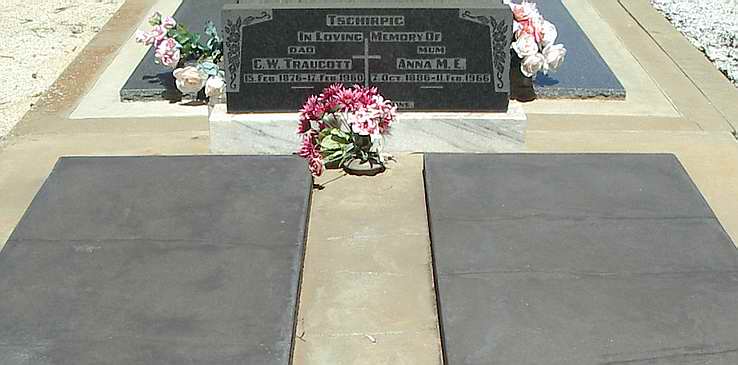
Grandmother Anna lived long enough for me to appreciate that she was a real talent at handcrafts,
e.g. crochet (doilies) and decorative dolls' dresses. It wasn't until the 1980s that I gained
a desire to know what my grandparents were like. Finally, in 2007 and 2008, I conducted video
interviews with their 2 remaining children – Ernest Herbert ("Snow") at Barmera and Norm at Lavington, NSW.
Another extract from the book "Moorook - Bend in the River" (page 55), directly quoting Mum's older sister Flora (Flo) –
| |
Traugott was born in Tanunda in 1876. He and Anna Maria
Elisabeth Milich were the second couple married in the original St. Petri Lutheran Church at Loxton
in 1904 [incorrect; it was 10 April 1907]. Anna was the third child and first
daughter in her family who lived on Section 13, Hundred of Pyap, from 1900. She faced responsibilities early in
life having had nine brothers and four sisters. Anna's mother practised homeopathy and was the much-loved midwife
of the Loxton district.
In 1910, Traugott, after a good season growing wheat at Bugle Hut, bought Section 23N (Yatco)
from Rein [Reinhold] Drogemuller. Their imposing homestead overlooking the lagoon was built by Gus Schier
in 1912. Strongly supported by his wife, Traugott became one of Moorok's early butchers.
He soon had competition with Bill Pope doing an opposition butcher round.
A ‘city-bred’ bride, new to the district, was somewhat taken aback when hearing the call ‘Butcher’
could not see a butcher's cart, but an open lorry. ‘Where's the meat?’ she said. ‘On
the back of the lorry’ replied the butcher, flinging back a tarpaulin to uncover an array of the
day's specials. She selected a leg of mutton. The butcher proceeded to crack it over the
wheel of the lorry, so that it would fit the roasting dish.
A new butcher boy would take his seat in the butcher cart, a slap on Belle's rump and they moved
off. The horse knew each place of calling, although some miles lapsed between.
The butchering business led Tschirpigs into the pig industry. Traugott is reputed to have
disrupted an agricultural Pig Husbandry meeting in the local hall, when Mr. McAuliffe was propounding
the advantages of the Landrace breed. ‘De Tamworth is de best,’ roared T.T.
Traugott Tschirpig was the agent for Queensland Insurance, a trustee of Loxton's first institute,
and a district council representative.
It was Anna who milked the cows, fed the pigs, dug the garden, made mettwurst and organised the
kids. Her husband said, ‘She would still be smiling if her bum caught fire!’
Traugott's pride and joy was the over-mantel in the sitting room. It extended from floor to
ceiling, eleven feet of it, with a number of mantel shelves with mirrors in between. It would
have been highly valued today, had it not been removed in the intervening years.
The highly decorative plaster of paris ceiling in the sitting room displayed a knife hanging down
with pigeons clinging to it, among masses of almond blossom. Sprays of painted purple wisteria
hung down the walls. From the floor, rose some metres of green paint, topped with pink roses.
Added to Traugott's love of butchering was the ownership of elegant cars. He possibly had
Moorok's first T model Ford. Then came the Strip-booth (which had to be sold to someone who
owned one, as no new parts were available), next a Chalmers, a Willys Knight with velvet-covered
seats, and a Chevrolet.
|
[I've corrected the obvious spelling errors].
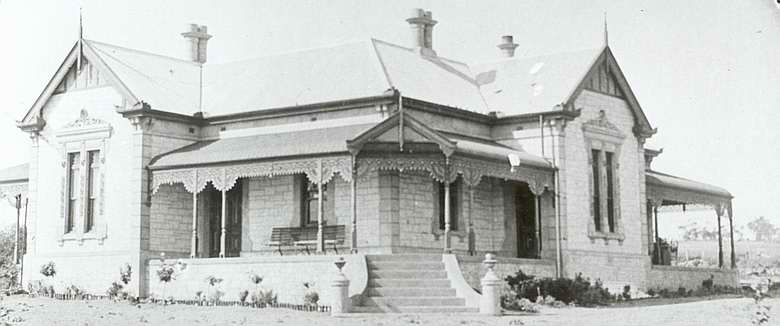
The family farm house south of Moorook, built in 1912.
My great grandparents :
I know little of Traugott's parents, except what's written on their grave stone at Krondorf (near the town of Tanunda).
 |
Actual inscription :
Hier Ruhet in Gott
* unsere *
LIEBE GATTIN UND MUTTER
J. CAROLINE TSCHRPIG
GEBORENE HAMPEL
GEB. 6TEN JULI 1854
GEST. 23TEN APRIL 1930
C.F.W. TRAUGOTT TSCHIRPIG
GEB. 16TEN JULI 1849
GEST. 2TEN NOV. 1936
SCHLIEST IHR AUGEN, SCHLIEST
EUCH ZU, SCHLAF MEIN LIEB,
IN SANFTER RUH, BIS DICH
JESUS WIRD ERWECKEN.
ICH HABE DICH JE UND JE GELIEBT, DARUM
HABE ICH DICH ZU MIR GEZOGEN AUS
LAUTER GÜTE. JER. 31,3
|
My translation :
Here rests in God
our
beloved wife and mother
Johanne Caroline Tschirpig
nee Hampel
born 6th July 1854
died 23rd April 1930
Carl Friedrich Wilhelm Traugott Tschirpig
born 16th July 1849
died 2nd November 1936
Close your eyes, be
finished, sleep my love,
in gentle rest, until
Jesus awakens you.
I have loved you at all times;
Therefore I have drawn you with
loving-kindness. Jeremiah 31:3
|
|
Google Earth users: click here for a Krondorf cemetery placemark. |
|
The Advertiser, Wednesday 5 July 1905 (page 11), Wednesday 19 June 1907 (page 9) and Wednesday 22
June 1910 (page 13) all reported results of Council Elections. In all cases, C.F.W.T.
Tschirpig was amongst the councillors elected in Tanunda.

Karl (or Carl) Friedrich Wilhelm Traugott and Johanne Caroline
My great great grandparents :
C.F.W. Traugott's parents Johann Gottfried Tschirpig and Johanne Louise Tschirpig (nee Fechner) came to Australia in 1847 with their
first 4 children and her 64 year old mother (who was already a widow) – Anna Elisabeth Fechner, nee Kluge (born 1783).
The sailing ship Gellert left Bremerhaven on 27th August 1847, and arrived at Port Adelaide on 21st December 1847 – a
voyage of 116 days. The passenger list is shown at
http://www.slsa.sa.gov.au/fh/passengerlists/1847Gellert.htm.
Neatly concealed in there is "Anna Bothe" – the Tschirpig family's 35 year old servant. In the handwritten
immigration journal (photocopies are in the State Library) from which the South Australian Register obtained its information,
she is listed below the Tschirpigs as "servant Ann Boten, 35." The foolish writer considered it appropriate to
translate proper nouns into English, so "Johann" became "John" and "Gottlieb" became "Godlove." He also recorded that
Elisabeth Fechner was 58 years old (not 64).
One day after the Gellert ship arrived at Port Adelaide, The South Australian Register newspaper published
this interesting article expressing "with satisfaction the continued
influx of a respectable class of passengers from Germany." During this era, international relations between Britain
and the German states (not yet a nation) were as relaxed as they are now, and the British monarchs were largely of German
origin (Queen Victoria's first language was German).
Johann Gottfried's grave stone at Krondorf informs that he originally came from Padligar on the
eastern border of the Province of Brandenburg, within the old German kingdom of Preußen (Prussia).
His wife might have been born in the same district. The servant is said to have come from
Brandenburg, which would be a reference to the province (as opposed to the city of Brandenburg, which is west of Berlin).
Many of the other passengers on the ship were recorded as coming from places described variously as
Preußen and Brandenburg; no fine details seem to be available.
Here is a link to the 1904 map of the Province of Brandenburg. From Züllichau (now named
Sulechów-zamek), Padligar is 7.3 km south east – on the northern side of a waterway which flows
west into the Oder river.
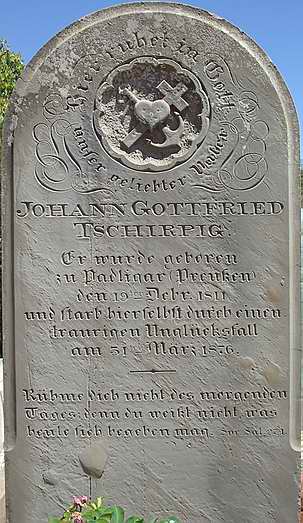 |
Hier Ruhet in Gott
unser geliebter Vater
JOHANN GOTTFRIED
TSCHIRPIG
Er wurde geboren
zu Padligar (Preußen)
den 19TEN Dcbr. 1811
und starb hierselbst durch einen
traurigen Unglücksfall
am 31TEN März 1876
Rühme dich nicht des morgenden
Tages; denn du weißt nicht was
hetue sich begeben mag. Spr. Sal. 27,1
|
Here rests in God
our beloved father
Johann Gottfried
Tschirpig
He was born
in Padligar (Prussia)
on 19th December 1811
and died in this town through a
sad accident
on the 31st March 1876
Do not boast about tomorrow,
because you do not know what
today might give you. Proverbs 27:1
|
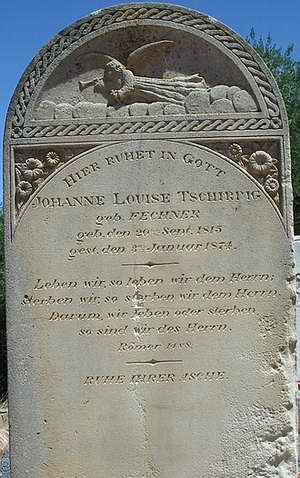 |
Hier ruhet in Gott
Johanne Louise Tschirpig
geb. FECHNER
geb. den 26ten Sept. 1815
gest. den 3ten Januar 1874
Leben wir, so leben wir dem Herrn;
Sterben wir, so sterben wir dem Herrn.
Darum, wir leben oder sterben,
so sind wir des Herrn.
Römer 14v8.
RUHE IHR ASCHE.
|
Here rests in God
Johanne Louise Tschirpig
nee Fechner
born 20th September 1815
died 3rd January 1874
If we live, we live to the Lord.
If we die, we die to the Lord.
Therefore, whether we live or die,
we are with the Lord.
Romans 14:8.
Rest your ashes.
|
Explaining how Johann Gottfried Tschirpig died "through a sad accident" –
The Argus (Melbourne), Tuesday 4 April 1876, page 4 reported :
| |
"A frightful accident happened at Tanunda on Tuesday afternoon,
March 28," the Adelaide Express and Telegraph reports, "to Mr. Tschirpig, an old man,
a respectable farmer living at Krondorf, which it is feared will have fatal results. Our
correspondent says that he drove away from Tanunda in his German waggon, drawn by two horses,
and somehow he must have lost the reins, and in trying to catch hold of them, over-balanced and
one of his legs got caught in the swingle tree, and thus he was dragged for about a mile.
He was first noticed by two little boys opposite Mr. Thwaite's house, with his body dragging on
the ground, singing out to the horses, which, however, bolted. Mr. Nei1 tried to stop
them near the Tanunda Creek Ford, but could not succeed, and it was only when they went up the
incline near Schierbrian, that they wore stopped by a man named G. Schulz, of Lyndoch.
Dr. Eberhard was at once fetched to where the poor man was lying insensible, and found on
examination that a large piece of skin was taken off the back of his head down to the bone ;
his clothes were torn to tatters ; the back part of the body was frightfully lacerated ; his
right elbow was crushed, and the elbow and wrist very much strained ; his left leg was broken,
the bones protruding through the skin, and the kneecap was damaged.
Concussion of the brain had set in. The doctor had the sufferer taken to his residence,
Krondorf, where he lay insensible to 1 o'clock, and even to-day it is difficult for him to
collect his thoughts enough to answer questions. Although he is still alive, Dr.
Eberhard holds out little hopes of his recovery."
|
Why they migrated :
Thousands of German people fled from religious persecution during the late 1830s. See
this Wikipedia article and this Wikipedia article. It made sense to emigrate to a country with lots of cheap land.
I believe the persecution finished when King Friedrich Wilhelm III died in 1840, so the Tschirpg
family were not in that category when they migrated 7 years later. Like thousands of others, they had heard the
excellent reports of the early settlers about the size and quality of the land, and decided that a better life beckoned.
To visit Padligar now, you need to find Podlegórz
in Poland. Google Earth placemark
Google Map
That doesn't mean the Tschirpigs were Polish. Their culture (including language) was profoundly German, and the
Kingdom of Preußen definitely identified itself as "German" in every way.
A century after the religious folk were chased out of their homeland, Germany lost World War 2 with two main consequences –
- The old Prussian patriotism was squashed by omitting the name from the re-divided German states.
- Germany lost a large chunk of its land in the north east back to Poland, who in turn lost their eastern regions to the
Soviet Union. All places reverted to their old Polish names. In that time of strong anti-German sentiment,
a lot of German people were forced to relocate west of the new border (the Oder River), although in a few areas, those with a
very friendly attitude towards the Polish people and their culture were allowed to stay and integrate. For a wider
perspective, read the Wikipedia article
German minority in Poland
and its linked article "History of the Germans in Poland."
One shouldn't be surprised to find Tschirpig types in Poland today, although I don't personally know of any.
Origin of the surname :
The origin of the name Tschirpig is still up for debate. Modern Polish people will tell you that it certainly
isn't Polish, and German people will tell you that it looks obviously German. Only one other possibility –
I know a United Methodist Church pastor in Germany whose work was training ministers in the
Lausitz region around 1990 (soon after
the fall of communism). He told me in 1999 that there are many surnames commencing with "Tsch" in that region, and
their origin is Sorbisch (Wendish).
I have been entirely unable to substantiate this observation so far.
Nevertheless, the Sorbisches Museum in Bautzen
(in the extreme east of modern Germany) is well worth a visit.
All photography is prohibited, but they sell souvenir books – your choice of German or Sorbisch language. To
uninformed people, written Sorbisch looks like Polish. The spoken languages are different, but when the Sorben
created a written form, they chose the Polish alphabet shapes rather than the German ones.
During the 1990s, the German state of Sachsen changed its constitution, so that the Sorben are now entitled to be taught
their ethnic language in schools. Over the centuries, the Sorben have been regarded as a bunch of mis-fits by many
rulers and governments (a bit like the Kurds in modern Turkey and Iraq – an ethnic group without any politically
defined territory), so this present time is a relatively golden period in Sorbisch history.
Mum's family history books :
- Hampel Family Book 1802 - 1979 ISBN 0 908046 15 4
The family of Johann Gottfried Hampel and his wife Anna Rosina (nee Linke) – including a bit of the Tschirpig side. Published in 1979.
- The Linke Families in Australia 1838 - 1980 ISBN 0 9594880 0 6
A collection of Linke families (sections A to S) who are either known or suspected of being related to each other.
Our family is in section H – Johann Gottfried Hampel and his wife Anna Rosina (nee Linke).
This is the same genealogy as in the Hampel Family Book.
It claims no proven connection to any of the other Linke families in the book.
Published to coincide with a Linke Family Reunion and thanksgiving service at Tanunda on 7th September 1980.
- The Nitschke Hentschke Family in Australia and New Zealand ISBN 0 646 009589 1
The family of Gottfried Nitschke and his wife Eva Elisabeth (nee Arlt) – our best genealogy of the Milich family.
Published to coincide with a Nitschke-Hentschke Reunion and thanksgiving service at Tanunda on Sunday 7th October 1990.
- Schrapel 1793 - 1977 ISBN 0 9598609 1 6
Family history and tree of Johann Gottlob Schrapel and his wife Maria Dorothea (nee Schefler) and their known descendants 1793 - 1977.
Published to coincide with a Schrapel Family Reunion and thanksgiving service at Tanunda Show Hall on Sunday 11th September 1977.
- A mention of The Milich family on pp. 2-3 of "Dust, Sweat & Tears as told to
Peter Read by Gordon Beer." Memories of Pata (a farming area immediately
south of Loxton) and the district. ISBN 0 9595020 0 9. Published: 1980.
- Moorook - Bend in the River ISBN 0 9593653 0 3 Published: 1982 Author: Joan Angas Wachtel 1915-2005
Facebook & Reunions :
Mum's brother "Snow" Tschirpig organised Tschirpig-Milich reunions for many years, starting in 1991. These
represent the extended families of both of his parents. Current organiser Lynn Schmaal created a Facebook entity:
http://www.facebook.com/MilichTschirpig.
You can send a Friend request.
Side Issue 1 : Other tribes in Australia
A few Australian relatives have contacted me after reading this page. In each case, they are descended from my great grandfather
Carl Friedrich Wilhelm Traugott Tschirpig. My real interest is limited to researching my own ancestry, as opposed to the
full family tree. However, the lack of contact from other branches made me casually curious about descendants of
C.F.W. Traugott's siblings. So, thanks to a push-start from Lyall Tschirpig (my 2nd cousin in Queensland), here is the
list of the migrant parents' children. There are some minor inaccuracies in the data at these links.
- Johanne Eleonore – born 11 Aug 1834; married Carl Friedrich Wilhelm Pohlner on 3 Aug 1854 at Bethany, SA; died 21 Sep 1909 at Angaston, SA
- Johann Gottlieb – born c.
1836 (age 11 at migration); married Anna Louise Neumann on 12 May 1859 at Bethany, SA; died Friday 4 March 1910 at
Lyndoch, SA as reported in The Advertiser, Wednesday 16 March 1910, page 10 :
SUDDEN DEATH AT LYNDOCH.
THE RESULT OF A FALL.
Gawler, March 10.
Mr. Johann Gottlieb Tschirpig, one of the oldest settlers in the Barossa district, died at
Lyndoch on Friday morning, owing to injuries received from a fall. He was walking across his
yard on the previous Monday, and owing to the heavy rains the ground being very slippery, he fell
on his face. No importance was attached to the injuries at the time, but fatal results followed.
The officer in charge of the police station at Lyndoch (Foot-Constable Ga??ner), reported the
matter to Mr. W. T. Collins, of Williamstown. As he was satisfied that death was due to
weakness brought on by kidney disease, and senile decay, accelerated by a fall, he did not consider
it necessary to hold an inquest, and gave an order for burial.
Mr. Tschirpig was 74 years old, and was born in Germany. With his parents he arrived in
this State in 1847, and proceeded with them to Krondorf, where his father began farming.
In 1859 he married, and took up some land at Eden Valley, where he remained for four years.
Next he took a farm near the old Lyndoch flax mill, and remained there till he retired from farming
in April last. He had since resided at Lyndoch. Mr. Tschirpig left a widow, but no children.
- Johanne Louise – born c. 1842 (age 5 at migration); married Johann Wilhelm August Lange on 7 August 1866.
This family is documented on the website of descendant Robert Elson.
- Johanne Maria Elisabeth – born c. 1846 (age 1 at migration); no other info.
- Karl Friedrich Wilhelm Traugott (my ancestor; see above) – born 16 Jul 1849; married Johanne Caroline Hampel; died 2 Nov 1936; buried at Krondorf.
- Ernestine Pauline Caroline Martha – born 6 Jul 1852 at Adelaide, SA; married Carl Ernst Kluge on 3 Nov 1876 at Bethany, SA.
Side Issue 2 : South African tribes
The more adventurous researchers amongst you might have discovered some Tschirpig families in South Africa – particularly
via Facebook. In April 2012 I was contacted by Tschirpig descendant Conrad Kassier, a South African masters degree
student briefly living in Poland. Through his grandmother's reminiscences, he knew his ancestral home town to be
Padligar, although early indications are that their emigration from Padligar to South Africa could be 1 or 2 generations
after our 1847 emigration to South Australia. In June 2012, Conrad was able to make a very quick visit to Padligar
(Podlegórz) accompanied by a Polish friend, and hopes to return for a thorough investigation in 2013. He found the
current Polish inhabitants to be friendly.
I put Conrad in contact with Heidrun Damaske (nee Tschirpig) in Vryheid, Northan Natal, who had contacted me
2 years earlier. Heidrun has a collection of info about the South African branches.
Further Research :
Other websites that could yield useful information (I haven't investigated yet) :
http://wiki-de.genealogy.net/Obraberg.
http://www.schoenwitz.de/ahnen/quellen/kblz.htm
(references to Padligar & Podlegórz church books).
http://www.genealogienetz.de/reg/BRG/neumark/auswanzu.htm.
Contact :
To contact me, send email to brian-vogt(at)netspace.net.au.
Commercial advertising is not welcome.
Home


